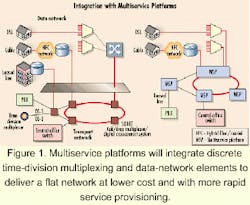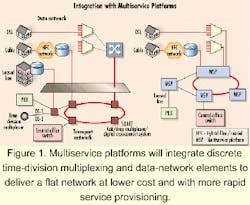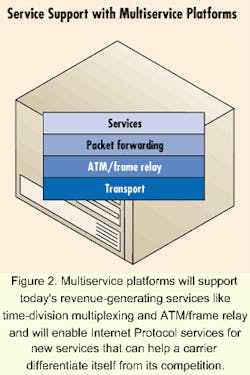Soft landing for SONET/SDH
Service providers and carriers are looking for solutions that will help them migrate from the static TDM world of today to a dynamic IP service-enabled network.
Mathew Steinberg
Redback Networks Inc.
Requirements for the access network are changing dramatically. Two key factors drive this change. First, end users are demanding more bandwidth at lower cost and want more control and flexibility of the services that they are buying. Second, many backbone providers are building long-haul networks with incredible amounts of capacity. This trend is helping to lower the costs of transport bandwidth, which in turn fuels the end-customers' desire for more bandwidth.
To meet these new requirements, carriers and service providers have three "simple" requests of system vendors:
- Help the carrier or service provider to massively scale their networks to meet the onslaught of data traffic.
- Enable the rapid provisioning and delivery of voice, video, and data services to satisfy customer demand.
- Support a migration to an Internet Protocol (IP) infrastructure to lower costs and meet end-user demands for control and flexibility.
Carriers and service providers have thus recognized the need to build a new access network capable of providing scalability and flexibility at cost points necessary to meet user requirements. It is worth examining these broad requirements further to determine how they can be best met.
While IP now dominates as a protocol and continues its rapid growth, it is often carried as part of today's time-division multiplexing (TDM), ATM, and frame-relay (FR) access networks before entering core IP networks. In access networks, TDM, ATM, and FR technologies continue to bear a majority of the traffic and generate most of the revenue in today's service-provider and carrier networks. Support of these and other legacy services will continue to remain critical because of their wide-scale deployment, acceptance as access technologies, and mass generation of revenue and profit today and for the foreseeable future.
Traditionally, SONET/SDH has been characterized as inflexible in accommodating dynamic bandwidth provisioning. Yet, despite its perceived inflexibility, SONET/SDH continues to record remarkable growth because it offers proven, standard, and consistent features essential to a service provider's operations: performance monitoring, fault management, configuration and connection management, and protection and restoration.From the operations perspective, service providers need to be able to perform a number of tasks such as test access, performance monitoring, provisioning, and problem isolation and resolution. Service providers also need to be able to prove to their customers that they are in fact delivering the contracted service. However, to survive and remain competitive, carriers need a cost-effective and flexible infrastructure that leverages SONET/SDH's capabilities, while they move toward mass customization of IP services.
The enormous demand for broadband services requires delivery when and where the customer wants it. Today, service provisioning and the delivery of broadband services occurs at a snail's pace because of the difficulty in provisioning multiple discrete network elements and performing the physical interconnection of those elements as well as laboring with independent management and provisioning systems.
Today's services largely focus on the delivery of bandwidth. Carriers and service providers also realize that these bandwidth pipes are largely filled with IP traffic with fixed service levels that provide corporate private-line service or Internet access. Static services like these offer the customer little to choose from and also do not allow the service provider to differentiate itself from the competition. End users are also demanding more bandwidth at lower cost and want more control and flexibility of the services that they are buying.
IP allows carriers and service providers to build their networks more efficiently, while providing the control and flexibility end users desire. Carriers and service providers are thus interested in gracefully evolving their business models from TDM, to packet, to IP services and being able to dynamically select TDM or packet services.
Carrier and service provider requirements are now demanding optically based equipment capable of providing TDM, Layer 2, and IP services from the same platform over the same infrastructure, and doing it at a significantly lower cost than today's technologies allow. Metro access equipment needs to function as the foundation for the new access network, while also supporting today's accepted legacy services. Multiservice platforms-which collapse multiple discrete network elements within a single platform (Figure 1)-will replace the large quantities of disparate transport and access equipment historically deployed for the same functionality and provide service creation vehicles for powerful new IP-based services.
When selecting new equipment, carriers and service providers should consider solutions that offer immediate benefits for today's services, while providing an optimal migration path to packet and IP-based services. In the new access network, carriers and service providers will leverage technology advances in silicon, optics, and IP software to create much simpler, easier-to-operate networks.
While data capabilities are significant in a multiservice platform, the system's ability to fit with present methods of operation is essential to its acceptance. Networks are vast, and a minimum of disruption is required. SONET/SDH is widely deployed, supports a large and growing TDM private-line business, and offers those proven features essential to a service provider's business. In addition to fitting with the present method of operation, a new platform must demonstrate first-cost savings, while making the network more efficient. That's accomplished by integrating the transport functions of traditional add/drop multiplexers (ADMs) and digital crossconnects (DCSs). That alone offers significant reduction in shelf count, floor space, and power requirements and provides operational savings due to decreased shelf interconnection and more streamlined provisioning.While private-line TDM demand is growing, carriers and service providers also want to use the network more efficiently. That means the key attributes of the data switching layer must be incorporated into multiservice platforms-traffic aggregation (statistical multiplexing gain) and LAN capabilities (e.g., transparent LAN and virtual LAN services). Traffic aggregation must occur over a variety of traffic interfaces and certainly must include ATM, FR, and Ethernet, particularly since Ethernet continues to grow in popularity as a low-cost interconnection interface. Statistical multiplexing allows the service provider to take advantage of the bursty nature of data traffic to over-provision the network, so that the average traffic flow nearly fills the available bandwidth.
A variety of interfaces in the same platform and the ability to add processing power when and where needed offer a "pay as you grow" strategy to carriers and service providers that preserves capital and more closely matches expenditures to revenue generation. Scalability is an important attribute to reduce network costs and have costs better track revenue.
Certainly, one aspect of scalability is having a wide variety of interfaces in a single platform (e.g., DS-1 to OC-192, including 10/100 Ethernet and Gigabit Ethernet) and the ability to support a number of those interfaces in a single platform. Yet, an important and often overlooked aspect is the addition of processing power when and where it is needed. Often large switch matrices are deployed with minimal amounts of traffic running through them. The switch matrices largely end up sitting idle until traffic grows to fill the switch capacity. Alternatives sometimes include deploying smaller switch matrices to reduce initial cost but require upgrades to higher-capacity matrices when additional capacity is required. Either approach strands valuable capital resources, while generating little revenue.
Attempts to optimize the transport and data layers have focused on reducing the element and operations costs of the service providers' networks. Integrating the functionality of discrete transport and data-network elements and enabling a data-aggregation capability are essential to reducing a carrier/service provider's costs and using bandwidth more efficiently.
But this is only one part of the solution. The carrier/service provider world is intensely competitive, and the companies involved want to enable new revenue-generating opportunities beyond the delivery and control of bandwidth that the transport and data layers offer.
While any network element used to construct networks must support the SONET/SDH functions of today and offer data-aggregation capabilities, these elements must also support seamless migration from TDM to IP and enable IP services. IP provides both the control and flexibility that service providers and end users desire. Enabling IP and IP services must occur with minimal new hardware, if at all, and through straightforward software upgrades or commands that permit a provider to migrate to the packet world without wholesale replacement of hardware platforms.
Providers must be able to leverage the same equipment to move data traffic from its TDM network onto a separate, more resourceful data network. Simple upgrades like these also provide a secondary benefit to the carrier or service provider, since they will minimize hardware and sparing requirements.
Architectures that present conventional Layer 1 functions (circuit switching and multiplexing) and enable Layer 2 and Layer 3 features (cell- and packet-based switching and routing) permit the customer to gracefully travel from simple to more complex services. IP services allow carriers and service providers the ability to offer new revenue-generating services above and beyond the delivery and control of bandwidth.
Thus, today's static networks will migrate to dynamic service-enabled networks. Multiservice platforms and provisioning systems both enable and simplify this evolution (see Figure 2). The requirement for fewer elements, fewer physical interconnects, and fewer management and provisioning systems greatly enhances service provisioning. At the same time, a management system designed with dynamic end-to-end provisioning and customer network management in mind provides the carriers, service providers, and end-customers with end-to-end control of the network. End-customers can now adjust the services at a moment's notice. Important ingredients of customer network-management and dynamic service provisioning are security features and integrated accounting capabilities that allow service providers to bill for services.
It is clear that service providers will adopt next-generation SONET/SDH devices that provide massive scalability, lower initial cost, and optimized service delivery. With these systems, carriers will deliver and provision bandwidth and services to the customer when and where the customer wants it. Their new equipment also will help them migrate from a static TDM-based network today to a dynamic IP service-based network tomorrow.
Systems that transport, aggregate, enable, and manage services, while maintaining the SONET/SDH capabilities that the carrier/service provider expects, are essential for building the new access network. Platforms that correspond best
with the current method of operation of today's SONET/SDH infrastructure, while migrating a service provider to IP services, stand the best chance of succeeding in this new access network.
A persuasive migration approach is essential in the optical-edge market. New products must demonstrate that the product will not force a carrier to alter its existing network, but rather illustrate how it will allow the provider to comfortably migrate in the direction of a more resourceful network over time.
Mathew Steinberg is director of product marketing at Redback Networks Inc. (Sunnyvale, CA). He can be reached at [email protected].


